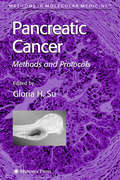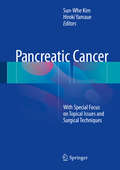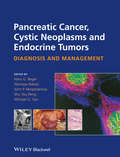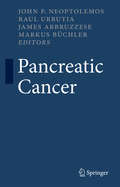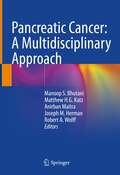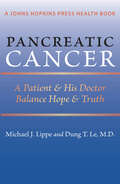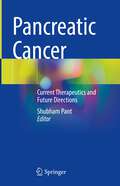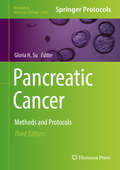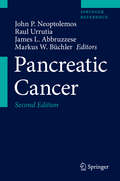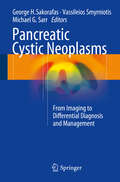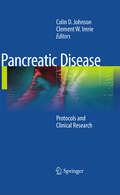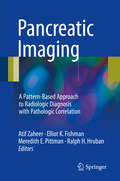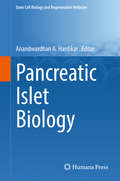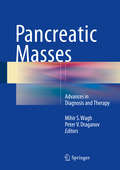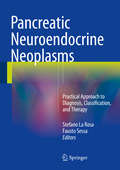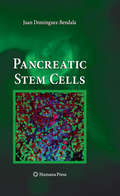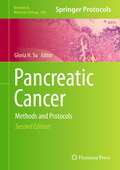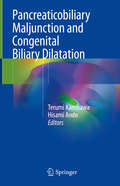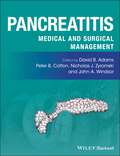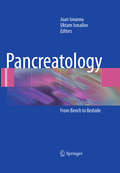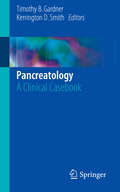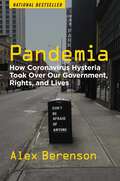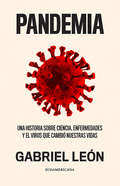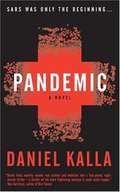- Table View
- List View
Pancreatic Cancer
by Gloria H. SuThis ambitious collection of essential yet novel methods for pancreatic cancer research or cancer research in general features an outstanding cast of authors who are esteemed leaders in the field. The authors provide a broad range of methods for molecular, biochemical, pathological, and statistical analysis of sporadic and familial pancreatic cancer, methods that can be applied not only to basic, but also to translational pancreatic research. Topics covered include in vitro cell cultures, in vivo mouse models, protein studies, mutation analysis, and treatment development.
Pancreatic Cancer
by Sun-Whe Kim Hiroki YamaueThis book provides state of the art knowledge on a broad range of clinical issues in pancreatic cancer, covering topics from screening and pathophysiology to surgical treatments. In particular, the focus is on current controversies and on evidence-based surgical techniques. Further aspects considered include the management of precancerous lesions, diagnostic methods, perioperative care and nonsurgical treatment. The description of surgical methods is supported by many helpful illustrations and important technical issues are carefully addressed. Determination of resectability and extent of surgery is also discussed. Based on recent developments in surgical techniques, some surgeons are performing more and more radical operations. It is essential, however, that surgical strategy is based on the best available evidence and surgeons will find that this book offers valuable help in achieving this aim. In addition, it will be a great asset in clinical practice for all who are involved or interested in the management of pancreatic cancer.
Pancreatic Cancer, Cystic Neoplasms and Endocrine Tumors
by John P. Neoptolemos Michael G. Sarr Shu You Peng Hans G. Beger Akimasa NakaoPancreatic Cancer, Cystic Neoplasms and Endocrine Tumors: Diagnosis and Management is a modern, expertly crafted and clinically focused guide to the diagnosis, management and best-practice care of patients suffering from pancreatic cancer, cystic neoplasms and endocrine tumours. Packed with outstanding figures and with reference to the leading society guidelines, its main focus is on the many endoscopic and radiologic diagnostic techniques, medical and surgical management of both full-blown cancer and other tumors, and the risks of each form of treatment. Also covered in detail are issues of tumor recurrence and long-term outcome of treatment. Brought to you by highly skilled national and international leaders in the specialty and an experienced editor team, this is an invaluable guide to practicing gastroenterologists and surgeons in the hospital and clinical environment, as well as oncologists and endocrinologists managing patients with pancreatic tumorous lesions.
Pancreatic Cancer, Volume 1
by John P. Neoptolemos Markus W. Büchler Raul A. Urrutia James AbbruzzeseWorldwide, there are an estimated 232, 000 new cases of pancreatic cancer annually. In the United States, it is the fourth leading cause of cancer death, and approximately 30,000 people die of pancreatic cancer each year. The disease is difficult to diagnose in its early stages, and most patients have incurable disease by the time they present with symptoms. The overall 5-year survival rate for this disease is less than 5%.<P><P> In organizing this handbook, Dr. Neoptolemos and his co-editors will produce a distinguished Major Reference Work devoted to pancreatic cancer. This handbook will have widespread appeal among clinicians, pathologists and basic scientists who are now struggling to understand this complex and rapidly expanding field.<P> Because of the recent and vast growth in both the clinical and scientific research being done in pancreatic cancer (there is currently an unprecedented investment by academia and industry in this field), each researcher’s knowledge of other specialty areas outside his or her own is now often quite limited. The aim of this book is to place these the tangible advances—those that are indispensable to all working on pancreatic cancer—readily at hand. The book will focus on advances that will not become dated, and the editors will choose authors who are the very best in each area.
Pancreatic Cancer: A Multidisciplinary Approach
by Anirban Maitra Joseph M. Herman Manoop S. Bhutani Matthew H. G. Katz Robert A. WolffThis book provides a comprehensive, state-of-the-art overview of pancreatic cancer. The text presents new data about risk factors and genetic predisposition for pancreatic cancer, highlights current screening strategies and preliminary results, and reviews diagnosis and staging of pancreatic cancer, with a focus on imaging evaluations, laparoscopy, endoscopic ultrasound-guided biopsies, and biomarkers. The book also spotlights emerging paradigms in pancreatic cancer management, such as minimally invasive surgical approaches and emerging radiation approaches, and provides valuable insight into the role of nutrition and early integration of supportive/palliative care for pancreatic cancer patients. Written by experts in the field, Pancreatic Cancer: A Multidisciplinary Approach is an invaluable resource for physicians and researchers with an interest in pancreatic cancer.
Pancreatic Cancer: A Patient and His Doctor Balance Hope and Truth (A Johns Hopkins Press Health Book)
by Michael J. Lippe Dung T. LeMichael J. Lippe was diagnosed with pancreatic cancer in 2007. This is his story, and the story of pancreatic cancer, narrated by Lippe and Dr. Dung T. Le, the physician who is treating him.In telling these stories, Lippe and Le alternate chapters. Lippe writes about the early signs that something was wrong; Le continues with a description of pancreatic cancer, its symptoms, and its treatments. Lippe talks about his prognosis, contemplates the prospect of death, and describes how he began to cope; Le explains the importance, for both doctor and patient, of balancing hope and truth. Lippe speaks frankly about the toll the disease takes on his marriage and family; Le offers a general picture of what most patients can expect with their illness. The book concludes with Lippe and Le’s reflections on their partnership in treating cancer, lessons they have learned, and their thoughts about the positive things that sometimes emerge from illness.Pancreatic Cancer offers clear explanations of what the disease is, describes what people with the disease will feel physically and mentally, and discusses current treatments and future directions of research. The authors hope that their honest yet hopeful perspective will help all people with cancer and those who care about them.
Pancreatic Cancer: Current Therapeutics and Future Directions
by Shubham PantPancreatic cancer is a challenging and complex disease characterized by a dense fibrotic stroma and an immunosuppressive tumor microenvironment. Until recently, there were no predictive biomarkers to personalize selection of targeted or biologic therapies as a part of standard of care treatment. Moreover, the regulatory immune population of cells creates a “cold”, non-immunogenic tumor that is resistant to immunotherapies including checkpoint inhibitors. However, in the last few years, there has been substantial progress in our understanding of the role mutations in the pathogenesis of disease leading to increased adoption of germline and next generation sequencing to identify mutations and fusions to optimize selection of therapies and select patients for clinical trials of targeted agents.This book provides a comprehensive, global overview on therapy for pancreatic cancer, exploring approved therapies and focusing on the “Next” in drug development including molecularly targeted therapy and efforts at “Drugging the Undruggable”: the KRAS mutation. It also addresses efforts at targeting the inhospitable stroma to improve drug delivery to the tumor cells, incorporating ct DNA (liquid biopsies) in the care of patients and recent advances in immunotherapy. Pancreatic Cancer: Current Therapeutics and Future Directions will illuminate these challenges, review existing therapeutics, and highlight current and future efforts to improve outcomes in this devastating disease. Useful to physicians, fellows, medical students, residents, physician assistants, nurse practitioners, pharmaceutical companies and researchers interested in pancreatic cancer, it will first explain management of localized disease including resectability and adjuvant and neoadjuvant therapies. Targeted therapies including molecular, immunotherapy, stroma and role of ctDNA or “liquid biopsies” will be addressed. Finally, the book will explore the important role of pain management, diet and exercise in improving outcomes in pancreatic cancer.
Pancreatic Cancer: Methods and Protocols (Methods in Molecular Biology #1882)
by Gloria H. SuThis third edition volume expands on the previous editions with discussions on the latest developments in 2D- and 3D-organoid cultures that allow for the execution of precision medicine, and in vitro studies of tumor cell growth and invasion. The chapters in this book explore protocols for evaluating macropinocytosis, stress granules, autophagy, metabolic alterations, and reactive oxygen species, which have proven to be possible therapeutic opportunities. The protocols described in this book look at both human and animal models, ranging from in vitro and in vivo, and will aid in future research of pancreatic cancer. Written in the highly successful Methods in Molecular Biology series format, chapters include introductions to their respective topics, lists of the necessary materials and reagents, step-by-step, readily reproducible laboratory protocols, and tips on troubleshooting and avoiding known pitfalls.Cutting-edge and comprehensive, Pancreatic Cancer: Methods and Protocols, Third Edition is a valuable resource for scientists and researchers who are interested in learning more about ways of improving patient care for pancreatic cancer.
Pancreatic Cancer: What You Need To Know
by John P. Neoptolemos Markus W. Büchler Raul Urrutia James L. AbbruzzeseIn organizing the second edition of this renowned Handbook, Dr. Neoptolemos and his co-editors have produced and updated a revised edition to the distinguished Major Reference Work devoted to pancreatic cancer. Like its preceding edition, the second edition continues to have a widespread appeal among clinicians, pathologists and basic scientists, who are now struggling to understand this complex and rapidly expanding field. Because of the recent and vast growth in both the clinical and scientific research being done in pancreatic cancer, (there is currently an unprecedented investment by academia and industry in this field), each research’s knowledge of other specialty areas outside his or her own is often quite limited. The aim of the new edition is to place the tangible advances, including new developments in surgical approaches with regards to resection techniques, the state of laparoscopic approaches, the growing impact of surgical approaches in the management of recurrent pancreatic cancer, controversies in the management of IMPN as the precursor lesion for PDAC and others – readily at hand. The second edition focuses on advances that will not become dated, and the editors have chosen authors, who are the very best in each area.
Pancreatic Cystic Neoplasms
by Michael G. Sarr George H. Sakorafas Vassileios SmyrniotisThis book provides a thorough overview of the detection of PCNs using modern imaging techniques and a clear guide to the recognition of the different subtypes of PCN based on their radiologic and histopathologic features. This volume will serve as an excellent aid to the selection of optimal therapeutic strategies based on preoperative diagnosis. A further important feature is the emphasis placed on radiologic, clinical, and surgical correlations. Pancreatic cystic neoplasms (PCNs) have been increasingly recognized during the past decade, mainly because of the widespread use of modern imaging modalities for the investigation of often unrelated abdominal symptoms. The three most common subtypes of PCN are serous cystic neoplasms, mucinous cystic neoplasms, and intraductal papillary mucinous neoplasms. These subtypes have distinct radiologic and histopathological features, and their biological behavior differs greatly. Accurate preoperative diagnosis is of prime importance in selecting the optimal therapeutic strategy: while serous cystic neoplasms are almost always benign, and may be treated conservatively, mucinous cystic neoplasms and intraductal papillary mucinous neoplasms have malignant potential, warranting an aggressive surgical approach, i. e. , pancreatectomy. Pancreatic Cystic Neoplasms will be of great interest to surgeons, gastroenterologists, radiologists, oncologists, and pathologists, and also to internists and residents in these specialties.
Pancreatic Disease
by Colin D. Johnson Clement W. ImrieThis book will contain the conclusions of a meeting from March 2007, of about 25 experts in pancreatology working together in small groups and plenary sessions to define the current state of knowledge in specific areas, and to develop ideal protocols and research questions for future investigation.
Pancreatic Imaging
by Elliot K. Fishman Atif Zaheer Meredith E. Pittman Ralph H. HrubanThis comprehensive teaching atlas covers virtually all pancreatic anatomy (including variants) and diseases in a pattern-based radiologic approach. Cases are presented as "unknowns", allowing the reader to analyze the findings and learn key points. Each teaching case includes a brief clinical history, images, a description of imaging findings, differential diagnoses, final diagnosis with images of gross pathology, and a discussion of key teaching points. The presented images have been acquired with the full range of relevant modalities, including state of the art technologies such as multidetector row dual-phase CT, 3D reformatting, and multiple MRI sequences. The book will help radiologists, radiology residents and fellows to sharpen their diagnostic skills by looking at a vast array of pathology from a major tertiary hospital (Johns Hopkins) and will also assist in preparation for radiology board examinations.
Pancreatic Islet Biology
by Anandwardhan A. HardikarThis comprehensive volume discusses in vitro laboratory development of insulin-producing cells. It encompasses multiple aspects of islet biology--from embryonic development and stem cell differentiation to clinical studies in islet transplantation, regulation of islet beta-cell regeneration, pancreatic progenitors, mathematical modelling of islet development, epigenetic regulation, and much more. The chapter authors represent leading laboratories from around the world who contribute their international perspectives and global expertise. Collectively, they provide the reader with a concise yet detailed knowledge of processes and current developments in islet regenerative biology. Pancreatic Islet Biology, part of the Stem Cell Biology and Regenerative Medicine series, is essential reading for researchers and clinicians in stem cells or endocrinology, especially those focusing on diabetes.
Pancreatic Masses
by Mihir S. Wagh Peter V. DraganovThis volume provides a comprehensive, state-of-the art review of the management of pancreatic lesions. The book reviews the differential diagnosis and pathology of different pancreatic lesions, profiles new advances in endoscopic evaluation, highlights new perspectives about imaging modalities, describes current treatment strategies and provides an algorithmic approach to management of pancreatic tumors. Recently published literature is placed in context with current management recommendations. The text also discusses the latest advances in minimally invasive techniques, such as Endoscopic Retrograde Cholangio-Pancreatography (ERCP) and Endoscopic Ultrasound (EUS). Written by experts in their fields, Pancreatic Masses: Advances in Diagnosis and Therapy is a valuable resource for gastroenterologists, surgeons and internists that helps guide patient management and stimulate investigative efforts.
Pancreatic Neuroendocrine Neoplasms
by Stefano La Rosa Fausto SessaThis book provides a broad overview of pancreatic neuroendocrine neoplasms, focusing on the most important developments in the technologies used to diagnose, classify and treat them. After a historical and epidemiological overview, the opening chapters examine the various diagnostic approaches (radiology, nuclear medicine, endocrinology, cytology and immunohistochemistry) and discuss the WHO classification. The functioning and nonfunctioning tumor types are then fully discussed, covering epidemiology, diagnosis, morphology and prognosis of each entity. Careful consideration is given to the molecular features that have contributed in understanding the pathogenesis of such neoplasms and may have potential implications for the diagnostic and therapeutic pathways. The final chapters consider the surgical and medical approaches to therapy, providing a practical and analytical overview of the available options. The book is written by a multidisciplinary team of worldwide-recognized experts and is addressed to radiologists, nuclear medicine physicians, endocrinologists, pathologists, surgeons and oncologists.
Pancreatic Stem Cells
by Juan Domínguez-BendalaFrom the discovery of Pdx1, the first "master gene" of pancreatic development, to the most recent findings on the role of microRNAs in beta cell homeostasis, the last fifteen years have seen an unprecedented advance in our understanding of the precise development and organization of the many different cell types that make up the pancreas. It is now widely acknowledged that the therapeutic differentiation of stem cells into pancreatic cells is an ambitious endeavor that will not succeed without a thorough understanding of the molecular processes underlying the native development of the organ. This book, aimed at experts and students alike, offers a comprehensive review of the state of the art in both pancreatic development and regeneration. The many strategies to differentiate adult and embryonic stem cells into pancreatic beta cells are also discussed in the context of potential therapeutic interventions for type I diabetes.
Pancreatic, 2nd Edition
by Gloria H. Suepigenetic alterations in cancer-causing genes such as oncogenes and tumor-suppressor genes. The second edition of Pancreatic Cancer: Methods and Protocols provides a broad range of protocols for molecular, cellular, pathological, and statistical analyses of sporadic and familial pancreatic cancer. It covers topics from in-vitro cell cultures to in-vivo mouse models, DNA to protein manipulation, and genetic and epigenetic analyses to treatment development. Written in the highly successful Methods in Molecular Biology™ series format, chapters include introductions to their respective topics, lists of the necessary materials and reagents, step-by-step, readily reproducible laboratory protocols, and key tips on troubleshooting and avoiding known pitfalls.<P><P> Authoritative and practical, written by highly renowned investigators with expertise in pancreatic cancer, Pancreatic Cancer: Methods and Protocols, Second Edition is an invaluable source of proven protocols to those who are interested in joining the fight against pancreatic cancer.
Pancreaticobiliary Maljunction and Congenital Biliary Dilatation
by Terumi Kamisawa Hisami AndoFrom embryology to epidemiology, pathophysiology, diagnosis, complications, treatment and prognosis, this book provides a comprehensive overview and the latest evidence-based data on pancreaticobiliary maljunction (PBM), a congenital malformation in which the pancreatic and bile ducts join anatomically outside the duodenal wall. Resulting in various pathologic conditions, such as biliary cancer and pancreatitis, immediate prophylactic surgery is recommended upon diagnosis. The standard operative procedure for congenital biliary dilatation (CBD) is extrahepatic bile duct resection with bilioenteric anastomosis, but the optimal treatment of adult patients with PBM without biliary dilatation remains highly debatable. This book, written by pioneering editors and authors provides latest data, sheds new light on the disease. With abundant figures to aid understanding, Pancreaticobiliary Maljunction and Congenital Biliary Dilatation appeals to a wide readership, especially adult and pediatric surgeons, physicians including gastroenterologists and endoscopists, as well as radiologists and pathologists.
Pancreatitis: Medical and Surgical Management
by Peter B. Cotton David B. Adams John A. Windsor Nicholas J. ZyromskiPancreatitis: medical and surgical management provides gastroenterologists and GI surgeons, both fully qualified and in training, with a focused, evidence-based approach to the most exciting developments in the diagnosis and clinical management of pancreatitis. Focusing mainly on the rapidly changing and innovative medical and surgical strategies to manage the disease, new surgical procedures such as endoscopic biliary intervention and minimally invasive necrosectomy to exciting new medical therapies like Antiprotease, Lexipafant, probiotics and enzyme treatment are all discussed. Full colour throughout, with over 250 colour illustrations and with reference to the latest clinical guidelines from the AGA, ACG and UEGW at all times, it is an essential consultation tool for all those managing patients with this increasingly common condition.
Pancreatology
by Juan Iovanna Uktam IsmailovBasic research discusses the implication of pancreatic stress protein in acute pancreatitis and pancreatic cancer and their possible role as therapeutic targets. Also, very original results show the unexpected role of lipids as mediators during acute pancreatitis. Gene screening strategies allow the detection of the genes responsbile for gemcitabine resistance of pancreatic cancer cells. They lead to the selection of several target genes, in order to suppress the resistance of cells to gemcitabine treatment. The mechanism by which tetrahydrocannabinol is anti-tumoral in pancreatic cancer cells is presented and the use of THC as a promising new therapeutic agent is discussed. Genetic data are shown concerning hundreds of families with hereditary chronic pancreatitis and their possible role in the pathogenesis of the disease. Another very original study addresses the prevention and treatment of pancreatic diseases with diat. In clinical research, convincing data about the use of endoscopic sphicterotomy in the management of acute bilary pancreatitis is presented, based on the experience of a Center highly specialized in pancreatic diseases.
Pancreatology
by Timothy B. Gardner Kerrington D. SmithThis clinical casebook provides a comprehensive yet concise state-of-the-art review of pancreatic disease. Presented in a case-based format, each case focuses on a different varient of pancreatic disease and pancreatic cancer, with sections on diagnosis and early detection, management of the disease, and treatment of complications from the disease. The role of neoadjuvant therapy for pancreatic cancer and emerging treatment algorithms for chronic pancreatitis are also highlighted in the text. Written by experts in the field, Pancreatology: A Clinical Casebook is a valuable resource for clinicians, surgeons, and researchers interested in caring for patients with pancreatic disease.
Pandemia: How Coronavirus Hysteria Took Over Our Government, Rights, and Lives
by Alex BerensonThe most important fact about the coronavirus pandemic that turned the world upside down in 2020 is that our response to it has been an epic overreaction driven by a disastrous confluence of public and private interests—all of them purporting to &“follow the science.&” Since the lockdowns began, millions of Americans have relied on the reporting of Alex Berenson. Exposing the hysteria and manipulation behind the worst failure of public policy since World War I, this clear-eyed journalist has been a critical source of reason and truth. The product of relentless investigation and research, Pandemia explains how an illness that many people will never even know they had became the occasion for economically ruinous lockdowns and the suppression of personal freedom on a previously unimaginable scale. Dispassionate, factual, and untainted by any agenda other than telling the truth, this is the account that pandemic-weary Americans desperately need.
Pandemia: Una historia sobre ciencia, enfermedades y el virus que cambió nuestras vidas
by GABRIEL LEONLa historia de las enfermedades infecciosas, los desaciertos de la medicina para enfrentarlas y la arremetida de una pandemia sin precedentes. Ameno y didáctico, el bioquímico y escritor Gabriel León relata el estudio de las enfermedades a través de la historia, y cómo la ciencia descubrió y controló, tardíamente muchas veces, a virus y bacterias. El gran avance que significó para la medicina el lavado de manos y cómo pudieron evitarse las cientos de miles de muertes de mujeres durante el parto, provocadas justamente por faltas de higiene. Su libro desclasifica estos desaciertos y, también, los avances de las sociedades y de la medicina en la lucha contra las pandemias que asolaron la población mundial a lo largo de la historia. Dedica un capítulo especial y detallado sobre la pandemia de covid-19 y gripes similares presentes en las últimas décadas.
Pandemic
by Daniel KallaHumanity is overdue for a new killer flu. So when a mysterious new strain of flu is reported in China, he expects trouble.
Pandemic
by Scott SiglerScott Sigler's Infected shocked readers with a visceral, up-close account of physical metamorphosis and one man's desperate fight for sanity and survival, as "Scary" Perry Dawsey suffered the impact of an alien pathogen's early attempts at mass extinction. In the sequel Contagious, Sigler pulled back the camera and let the reader experience the frantic national response to this growing cataclysm. And now in Pandemic, the entire human race balances on the razor's edge of annihilation, beset by an enemy that turns our own bodies against us, that changes normal people into psychopaths or transforms them into nightmares. To some, Doctor Margaret Montoya is a hero--a brilliant scientist who saved the human race from an alien intelligence determined to exterminate all of humanity. To others, she's a monster--a mass murderer single-handedly responsible for the worst atrocity ever to take place on American soil. All Margaret knows is that she's broken. The blood of a million deaths is on her hands. Guilt and nightmares have turned her into a shut-in, too mired in self-hatred even to salvage her marriage, let alone be the warrior she once was. But she is about to be called into action again. Because before the murderous intelligence was destroyed, it launched one last payload -- a soda can-sized container filled with deadly microorganisms that make humans feed upon their own kind. That harmless-looking container has languished a thousand feet below the surface of Lake Michigan, undisturbed and impotent . . . until now. Part Cthulhu epic, part zombie apocalypse and part blockbuster alien-invasion tale, Pandemic completes the Infected trilogy and sets a new high-water mark in the world of horror fiction.
